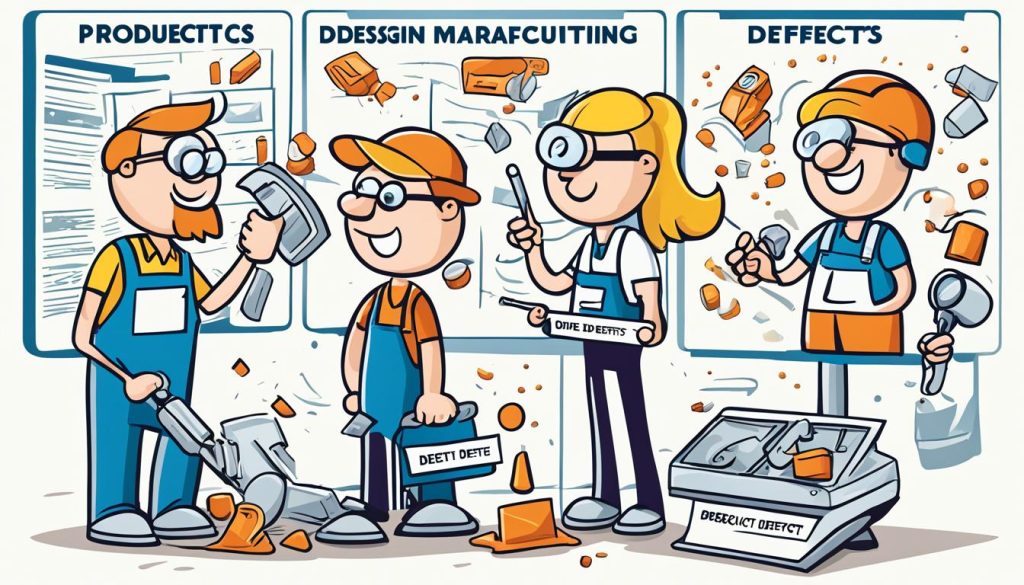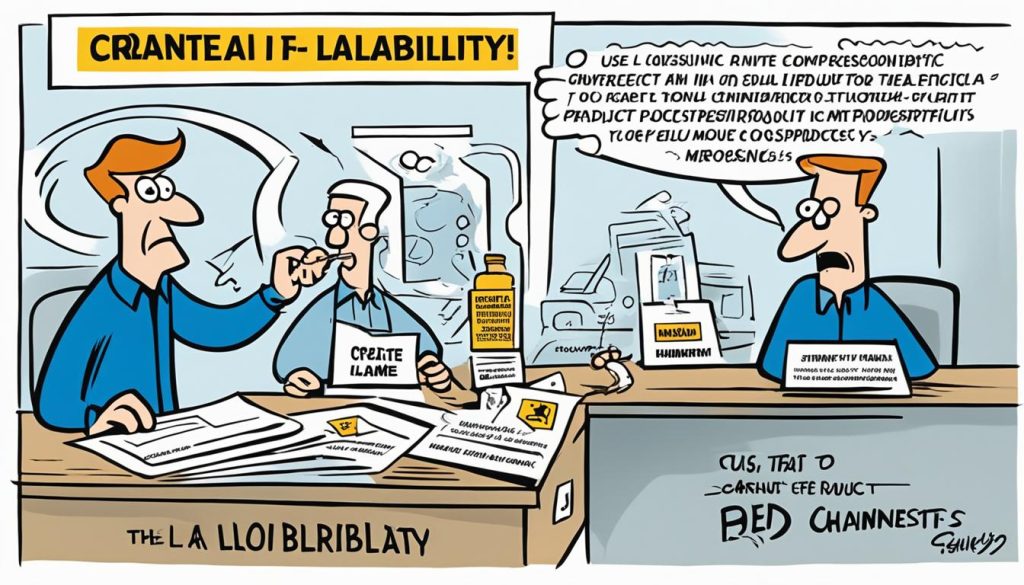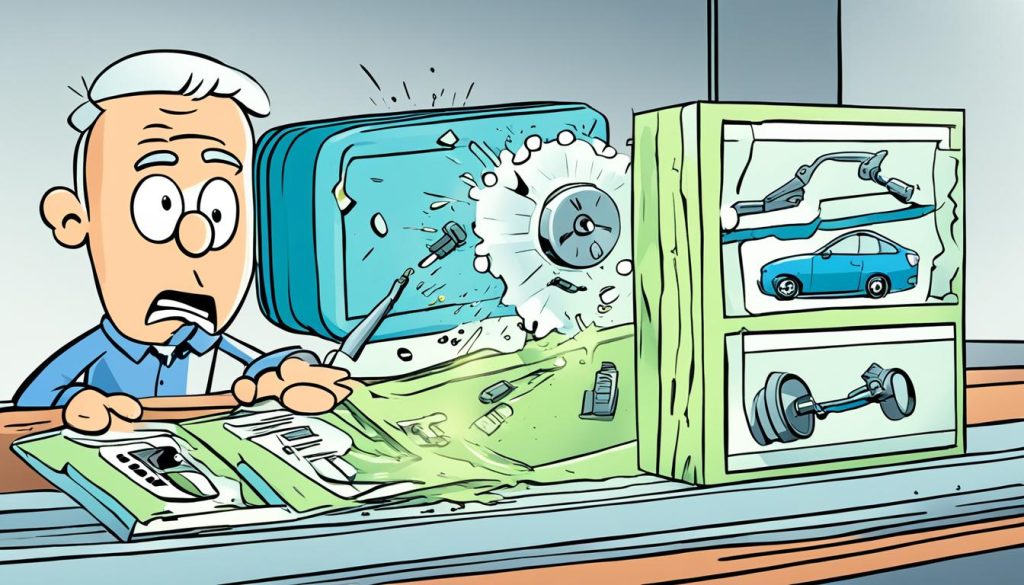Product liability cases are complex, involving legal theories like negligence and strict liability. If a product hurts you, you might get money for medical bills, lost wages, pain, and even death1. These cases are tough because you must prove someone was at fault for the product’s flaws.
When you win a product liability case, you can make companies like manufacturers and sellers pay1. Products can be dangerous because of bad design, missing safety features, hidden flaws, or unclear instructions1.
If a product hurt you, talking to a skilled personal injury lawyer is key. They help collect evidence, find who was at fault, and fight for your rights to get fair pay1.
Key Takeaways
- Product liability cases may involve multiple legal theories, including negligence, breach of warranty, and strict liability.
- Successful claims can lead to compensation for medical expenses, lost wages, pain and suffering, and other damages.
- Various parties, such as manufacturers, distributors, and retailers, can be held liable for product defects.
- Defects can include dangerous designs, missing safety features, hidden defects, and inadequate instructions or warnings.
- Consulting an experienced personal injury attorney is crucial for navigating the complexities of a product liability case.
What is Product Liability?
Product liability is a key legal concept. It makes sure manufacturers and others in the2 production chain are responsible for injuries from faulty products. This rule comes from2 torts law and is strict, meaning the company can be blamed even if they weren’t careless or mean.
Definition and Overview
Products liability means those making and selling products can be held accountable for harm caused by defects2. This includes everyone from part makers to sellers. People hurt by bad products can get money for medical costs, lost work, pain, and emotional issues2. You don’t have to prove they were careless or wanted to harm you, unlike in other cases like car accidents2.
In the U.S2., over 11 million people went to the ER in 2021 for injuries from products2. The rule is strict, so you only need to show the product was faulty and it caused your injury2. You can sue for many reasons, like design or manufacturing flaws, not warning about dangers, or breaking promises2. You usually have one to four years to sue, with most states giving you two years2.
Many can be sued in product liability cases, like makers, suppliers, and sellers2. Laws have changed to let anyone affected by a faulty product sue, not just those with a direct contract2. Common cases are about faulty cars, drugs with hidden risks, and broken medical devices2.
“Product liability is a crucial area of law that holds manufacturers, distributors, and other parties in the chain of manufacture responsible for injuries or damages caused by defective products.”
In injury cases, money damages help fix economic losses like medical bills and lost wages, and non-economic losses like pain and suffering3. These damages aim to put you back where you were before the injury3. Punitive damages punish bad behavior and aim to stop it from happening again, often leading to big awards in product liability cases3.
In 2020, a New Jersey jury made Johnson & Johnson pay $750 million in punitive damages, later cut to $186.5 million, to four people who got cancer from asbestos in baby powder3. In 2019, a jury ordered Bayer to pay $2 billion in punitive damages to a couple who got cancer from Roundup after using it for over 30 years. This was later reduced to $86.7 million3.
Types of Product Defects
Product liability cases often involve three main types of defects: design, manufacturing, and marketing defects4. It’s important to know the differences to figure out who is liable and to get compensation for defective products.
Design Defects
Design defects are flaws in the product’s design that make it dangerous, even if it works as it should4. For example, a car that flips easily, sunglasses that don’t block UV rays, or an electric blanket that causes electrocution4. These issues come from the product’s design, not how it was made.
Manufacturing Defects
Manufacturing defects happen during production and affect only a few products4. Examples include a broken chain on a swing set, cough syrup with a harmful substance, or a moped without brake pads4. These defects are usually found in a specific batch and can be hard to trace back to the source.
Marketing Defects
Marketing defects are about wrong instructions, labels, or not warning about dangers4. For instance, an electric tea kettle without steam valve warnings, cough syrup without warnings about drug interactions, or a product that causes burns without safety instructions4. Law requires products to have clear warnings and instructions, and not having them can lead to liability.
Knowing the type of defect is key to figuring out who is responsible5. Many companies are involved in making a product, making it hard to find the one responsible for a defect5. A lawyer specializing in product liability can help find where the defect came from and who is to blame5.

People hurt by product defects can get compensation for medical bills and other costs5. For example, a lawsuit won $19.1 million for someone hurt by a defective product5. The Merck/Vioxx case settled for $4.85 billion over issues with the painkiller Vioxx6. Cases like Lewy v. Remington Arms Co. Inc and Bullock v. Philip Morris show big awards for design flaws and not warning users6.
| Type of Defect | Description | Examples |
|---|---|---|
| Design Defects | Inherent flaws in the product’s design that make it unreasonably dangerous, even if the product functions as intended. | Car prone to flipping over, sunglasses failing to protect from UV rays, electric blanket causing electrocution. |
| Manufacturing Defects | Flaws that occur during the production process, where only a few out of many products are defective. | Swing set with a cracked chain, cough syrup containing a poisonous substance, moped missing brake pads. |
| Marketing Defects | Improper instructions, labels, or failure to warn consumers of latent dangers in the product. | Electric tea kettle missing warnings on steam valve, cough syrup lacking drug interaction warnings, burn-causing product sold without safe handling instructions. |
In summary, knowing about product defects is key to figuring out who is liable and getting compensation564. Whether it’s a design flaw, a manufacturing issue, or a marketing defect, laws help hold companies responsible for their products’ dangers.
product liability, personal injury, defective products
Personal injury law deals with lawsuits for harm caused by someone’s careless or intentional actions7. To win, the injured person must show the person at fault had a duty, broke it, and this led to their harm7. Common cases include car accidents, faulty medical devices, and exposure to harmful chemicals7.
In cases about defective products, people can use different legal arguments to claim damages7. For example, a faulty pressure cooker causing burns has led to lawsuits7. Also, not having safety features in machines like lawnmowers has resulted in claims when they should have had automatic stops or guards7.
Defective medical devices have caused injuries and illnesses, leading to lawsuits7. Not having clear warnings or instructions on products has also led to successful claims7. A pasta machine that didn’t stop when opened caused an amputation, showing the responsibility of the U.S. distributor7.
Food contamination or toxic chemicals in products have caused injuries, leading to legal action7. Medications with unknown risks have caused serious health issues, resulting in lawsuits7. If you’re hurt by a faulty product, see a doctor, document your case, and talk to a lawyer quickly to act within the legal time limits7.
In the U.S., most states have strict rules for product liability cases, thanks to a key 1963 court decision8. The Restatement of Torts (3rd): Product Liability in 1997 brought big changes to product liability law8. Winning a product liability case means proving the product was faulty and caused your injury8.
Injured people can seek damages like lost wages, pain, and medical costs in product liability cases8. Lawsuits aim to show a defective product caused the injury, using various legal arguments8. Over time, product liability law has changed, moving away from old rules and towards strict liability8.
Every year, consumer products cause over 22,000 deaths and 29 million injuries, says the Consumer Product Safety Commission9. These products lead to more than $500 billion in harm each year9. Defects can range from car parts to baby items, causing serious issues9.
Product liability cases cover many areas, like faulty tires and unsafe tools9. Most defects happen during production, affecting just a few items9. To win, you must prove the product is faulty, often due to design, making, or marketing issues9.
Establishing Liability
In product liability cases, strict liability is key. It means the defendant can be held liable if the product was defective, even if they didn’t mean to cause harm10. But, courts might use other tests like the risk-utility test or the consumer expectation test to lessen strict liability if a product is flawed10.
Strict Liability
Strict liability makes manufacturers or sellers responsible for injuries from defective products, without needing to prove they were careless10. This means the defendant must prove the product is safe or that its benefits outweigh the risks10.
Courts might also look at the risk-utility test or the consumer expectation test to decide liability. The risk-utility test compares the product’s usefulness to its dangers. The consumer expectation test sees if a normal person would think the product is faulty when used as meant10.
The Supreme Court case Bristol-Myers Squibb Co. v. Superior Court of California (2017) made it harder for plaintiffs to switch courts in product liability cases. This could affect how liability is decided10.

To figure out liability in product cases, you need to look at the details, the defect, and the laws where the case is heard11. Lawyers who know about product liability are key in handling these complex issues and getting fair compensation for those hurt11.
“The concept of strict liability in product liability cases places the burden of proof on the defendant, requiring them to justify the product’s design or demonstrate that the risk of harm is outweighed by the product’s utility.”
Defenses and Limitations
When people get hurt from faulty products, they might look for legal help through product liability claims. But, the people being sued often use different defenses to reduce their blame. It’s key for both sides to know these defenses and limits in product liability law.
A common defense is contributory negligence, where the defendant says the injured person was also to blame for the injury12. Some cases let both sides share the blame, based on how much fault each has13. The defendant might also say the product was changed or used in a way they couldn’t have predicted, making them not liable14.
Statutes of limitation are another hurdle for those filing claims. In Pennsylvania, you have two years from when the injury happened to sue12. If you don’t sue in time, you can’t sue at all14. Some places also have laws that stop you from suing after a certain time, even if the product is still dangerous14.
Trying to forum shop and sue in a better state has been made harder by recent Supreme Court decisions12. Companies might say they made the product as safely as they could with the technology they had14.
Understanding the many defenses and limits in product liability cases is tricky. It’s often best to get help from lawyers who know the law and your situation well. This is true for both those suing and those being sued121314.
Conclusion
If you’ve been hurt by a product you think is faulty, getting advice from a skilled15 personal injury lawyer is key. They will check your case to see if you have a good chance of winning16. They also make sure your rights are protected and document your case early on.
Product liability cases can be tricky, with many kinds of defects that might have caused your injury17. A knowledgeable15 personal injury lawyer can guide you through the complex laws. They aim to get you the right compensation for your medical bills, lost earnings, and suffering16.
At Rapoport Weisberg & Sims P.C., our team of15 product liability lawyers and staff are dedicated to helping clients hurt by faulty products15. We offer a free case check and work on a no-win, no-fee basis15. This means you don’t pay anything upfront unless we win your case15. Let us use our skills and resources to fight for your justice and recovery15.
FAQ
What is product liability?
Product liability means anyone in the making and selling of a product can be held responsible for harm it causes. This includes the maker of parts, the company that puts them together, wholesalers, and sellers. It’s based on tort law and is strict, meaning the maker can be blamed even if they didn’t mean to or try hard enough.
What are the main types of product defects?
There are three main kinds of product flaws that can lead to lawsuits. Design flaws are built-in problems that make the product dangerous. Manufacturing flaws happen during making and affect a few products. Marketing flaws come from wrong instructions, labels, or not warning about dangers.
How does product liability relate to personal injury cases?
Personal injury cases are about suing for harm caused by someone’s careless or intentional actions. To win, the person suing must show the defendant was supposed to be careful, wasn’t, and that caused their injury. These cases often involve car accidents, faulty medical devices, or exposure to harmful chemicals.
Is product liability a strict liability offense?
Yes, being liable for product defects is strict, meaning blame is placed on the maker even if they didn’t mean to or try hard enough. Some courts might look closer if the product is still useful or if a normal person wouldn’t see it as flawed.
What defenses can defendants raise in product liability cases?
Defenders might say the injured person was also to blame. There are also time limits to file a claim. Recent Supreme Court decisions have made it harder for people to file in places that seem more favorable to them.
What should I do if I’ve been injured by a defective product?
If a product has hurt you, talk to a skilled personal injury lawyer right away. They will look into your case to see if you have a good chance of winning. They can also protect your rights and gather evidence early on.
Source Links
- Understanding Product Liability Lawsuits | Defective Product
- What Is Product Liability? (2024 Guide)
- Damages in Product Liability Cases
- Types of Product Liability Claims
- Types of Product Defects
- 3 Types of Product Liability Cases | Adam S. Kutner, Injury Attorneys
- Product Liability Cases – Product Liability Lawsuit – Find An Attorney
- Introduction to product liability law
- Defective Products and Product Liability Attorney Baltimore | David B. Shapiro
- products liability
- What Goes Into Proving A Product Liability Case?
- 7 Most Common Defenses to Product Liability Claims | Anapol Weiss
- Defenses in a Product Liability Lawsuit
- Common Defenses to Product Liability Claims
- Defective Products & Product Liability Lawsuits Frequently Asked Questions
- Compensation for Injuries Caused by Defective Products
- Anatomy of Product Liability: Causes and Consequences

